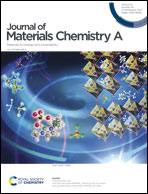Metal oxyhydroxide nanosheet-assisted fabrication of ultrathin carbon molecular sieve membrane for hydrogen separation†
Abstract
Carbon molecular sieve (CMS) membranes with high thermal and chemical stabilities are attractive for efficient gas separation. However, the scalable fabrication of ultrathin CMS membranes with high separation properties remains a challenge. In this work, FeCoNi oxyhydroxide nanosheets were used to fabricate an ultrathin poly(furfuryl alcohol) nanocomposite layer on a porous alumina support via in situ polymerization of furfuryl alcohol and then produce a carbon molecular sieve membrane through carbonization. The transformation of FeCoNi oxyhydroxide nanosheets to nanoporous oxide nanosheets during the pyrolysis process is beneficial for enhancing the gas permeance of the carbon membrane. The resulting carbon membrane with a thickness of 95 nm possesses excellent gas separation properties, a permeance of 3.3 × 10−8 mol m−2 Pa−1 s−1 and an ideal H2/CO2 selectivity of 11.4. This work provides a novel route to the scalable fabrication of ultrathin and defect-free carbon molecular sieve membranes.



 Please wait while we load your content...
Please wait while we load your content...